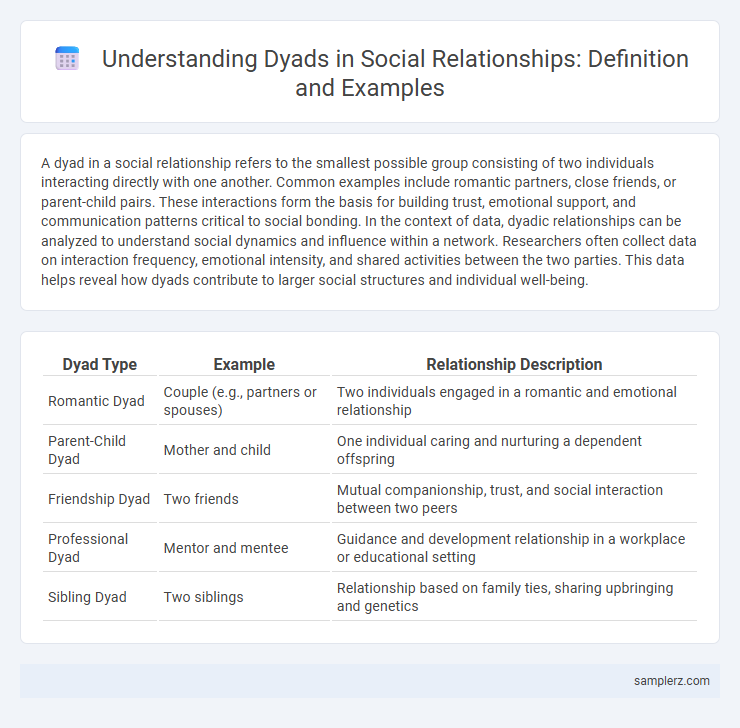A dyad in a social relationship refers to the smallest possible group consisting of two individuals interacting directly with one another. Common examples include romantic partners, close friends, or parent-child pairs. These interactions form the basis for building trust, emotional support, and communication patterns critical to social bonding. In the context of data, dyadic relationships can be analyzed to understand social dynamics and influence within a network. Researchers often collect data on interaction frequency, emotional intensity, and shared activities between the two parties. This data helps reveal how dyads contribute to larger social structures and individual well-being.
Table of Comparison
| Dyad Type | Example | Relationship Description |
|---|---|---|
| Romantic Dyad | Couple (e.g., partners or spouses) | Two individuals engaged in a romantic and emotional relationship |
| Parent-Child Dyad | Mother and child | One individual caring and nurturing a dependent offspring |
| Friendship Dyad | Two friends | Mutual companionship, trust, and social interaction between two peers |
| Professional Dyad | Mentor and mentee | Guidance and development relationship in a workplace or educational setting |
| Sibling Dyad | Two siblings | Relationship based on family ties, sharing upbringing and genetics |
Defining Dyads in Social Relationships
A dyad in social relationships refers to a group of two people whose interaction forms the foundation of interpersonal communication and connection. Examples include close friendships, romantic partnerships, or parent-child pairs, where mutual influence and emotional exchange are direct and immediate. The dyadic structure emphasizes reciprocity, intimacy, and the unique dynamic created by the presence of exactly two individuals.
Parent-Child Dyad: Foundation of Bonds
The Parent-Child Dyad exemplifies a fundamental social relationship, establishing the foundation for emotional attachment and secure bonding. Early interactions within this dyad promote trust, communication skills, and conflict resolution, essential for healthy psychological development. Studies reveal that consistent nurturing behaviors in this dyad significantly enhance child resilience and long-term social competence.
Romantic Partners: Intimate Dyadic Connections
Romantic partners form a classic example of a dyad, representing an intimate dyadic connection characterized by deep emotional bonds and mutual interdependence. These relationships involve intense communication patterns, shared experiences, and reciprocal support, fostering trust and long-term commitment. Research in social psychology highlights that the quality of dyadic interactions significantly influences relationship satisfaction and stability.
Friendship Dyads: Trust and Support
Friendship dyads exemplify social bonds where trust and support are critical for relationship stability and emotional well-being. In these dyads, mutual reliability fosters open communication and shared coping mechanisms during life challenges. The strength of trust in friendship dyads directly influences conflict resolution and long-term relational satisfaction.
Sibling Dyads: Lifelong Social Ties
Sibling dyads represent enduring social bonds that significantly influence individual development and emotional support throughout life. Studies reveal that sibling relationships often provide unique companionship, conflict resolution opportunities, and social learning experiences distinct from other social connections. These lifelong ties contribute to psychological resilience and shape social identity across different life stages.
Mentor-Mentee: Guiding Relationship Dyads
The mentor-mentee dyad exemplifies a guiding relationship where knowledge transfer and personal growth are central. This dyadic interaction fosters skill development, emotional support, and goal alignment, enhancing both professional and personal outcomes. Effective mentor-mentee pairs rely on trust, active communication, and mutual respect for sustained success.
Coworker Dyads: Professional Collaboration
Coworker dyads represent professional collaboration where two employees interact regularly to achieve shared work goals, enhancing productivity and team cohesion. These dyads often involve reciprocal communication, trust, and mutual support, critical for problem-solving and innovation within workplace settings. Effective coworker dyads contribute to organizational success by fostering a cooperative environment and reducing conflicts.
Therapist-Client Dyad: Therapeutic Alliance
The Therapist-Client dyad exemplifies a crucial relational dynamic where trust, empathy, and active listening foster a strong therapeutic alliance, essential for effective psychological treatment outcomes. Research indicates that a robust therapeutic alliance within this dyad significantly correlates with client satisfaction, adherence to therapy, and symptom reduction. Key elements such as mutual respect, goal consensus, and emotional bond serve as foundational components strengthening the therapist-client interaction.
Teacher-Student Dyad: Educational Interaction
The teacher-student dyad exemplifies a dynamic educational interaction essential for effective learning outcomes. In this relationship, teachers provide structured knowledge and mentorship, while students actively engage through questions and feedback, fostering cognitive development. Research highlights that strong dyadic communication enhances academic performance and motivation within classroom settings.
Cross-Cultural Dyads: Bridging Social Differences
Cross-cultural dyads, such as friendships between individuals from distinct ethnic backgrounds, exemplify the complexity of navigating cultural norms and communication styles. These relationships require heightened intercultural awareness and adaptability to bridge social differences effectively. Successful cross-cultural dyads foster mutual understanding and respect, contributing to social cohesion in diverse communities.

example of dyad in relationship Infographic
 samplerz.com
samplerz.com